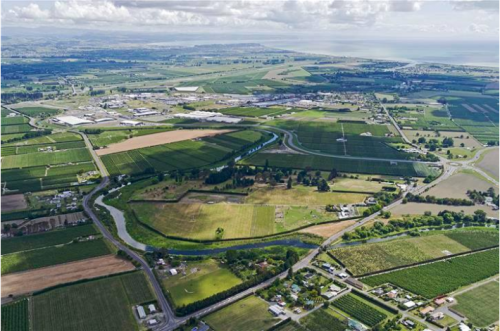
I want to...
Current filter:
Current filter:

Kia ora koutou kei te rohe whānui o Heretaunga e whakakaurerangia Te Wiki o te Reo Māori 2020. Nau mai, haere mai ki tēnei kaupapa e whakanui ana i ngā tāhuhu kōrero o te takiwā e kiia nei, ko Heretaunga Tūturu.
Te Ara Kahikatea is the name of the stretch of road that links Pakowhai Road and State Highway 51 (the old State Highway Two / Karamū Road) that was officially opened in February 2019. Nō hea kē tēnei ingoa? Where does this name come from / how did it come about?
The name Kahikatea is significant for a number of reasons besides its primary existence as Aotearoa New Zealand’s tallest indigenous tree. Up until the late 19th century when much of Heretaunga (modern day Hastings) was covered in swamps and wetlands, these conditions favoured the Kahikatea, which grew prevalently across Heretaunga and in particular, in the area through which the arterial link traverses.
The stand of forest known as Pakiaka or Pakiaka Bush, which lay between Napier and Lawn Roads was surrounded in swamps and was heavily populated with Kahikatea. The first European settlers to Heretaunga procured Kahikatea from Pakiaka to build their houses as settlement increased, development ensued, and Hastings grew.
Local cultural narratives give reference to the Kahikatea being an offspring of Tānemahuta and Hine-waoriki whose siblings were Matai, Rimu, Pukatea, Kauri and Tanekaha (conifers with small rough foliage). However, unlike its siblings, Tānemahuta located Kahikatea to the wetlands and swampy marshes and gave it a shallow root system; thus requiring Kahikatea to adapt and grow forth by developing an underground buttressed root system.
The large and great Kahikatea forests such as Pakiaka Bush were reminiscent of the Kahikatea grouping closely with other Kahikatea, intertwining their buttressed roots with each other for support in the unstable swampy ground. This underground root system subsequently, gained strength in this way to better support the large trees that the Kahikatea eventually matured in to, albeit in swampy wetlands.
The stability of this buttressed root system serves as a metaphor to encapsulate the essence of how the Whakatū Arterial Link Project was progressed. There was a lot of significant work at the forefront of the project, behind the scenes and at the eventual opening with mana whenua including Ngāti Hori, Ngāti Hāwea, Ngāti Hinemoa, and the Whakatū Action Group, to maintain and strengthen the holistic integrity of the project as well as moving forward.
The name Te Ara Kahikatea is therefore fitting and testament to the stability of the Whakatū arterial link project and to the cultural and ecological narratives that underpin the very place. For instance, that collaboration, co-construction and partnership that has manifest through notions of working ‘kanohi ki te kanohi, pakihiwi ki te pakihiwi – face to face, shoulder to shoulder’ is indicative of the Kahikatea’s buttressed root system that supports the whole forest.
Kāti rā, anei mātau anō o Te Kaunihera ā-Rohe o Heretaunga e tukuna atu ngā mihi ki a Ngāti Hori, Ngāti Hāwea, Ngāti Hinemoa, ki te Rōpū Hapori o Whakatū me ērā atu o ngā rōpū i mahi ngātahi hei whakatutukingia te kaupapa nei. Mei kore ake nei koutou hei tohutohu i a mātau o te Kaunihera; tēnā rawa atu koutou katoa.
15 September 2020
Disclaimers and Copyright
While every endeavour has been taken by the Hastings District Council to ensure that the information on this website is
accurate and up to date, Hastings District Council shall not be liable for any loss suffered through the use, directly or indirectly, of information on this website. Information contained has been assembled in good faith.
Some of the information available in this site is from the New Zealand Public domain and supplied by relevant
government agencies. Hastings District Council cannot accept any liability for its accuracy or content.
Portions of the information and material on this site, including data, pages, documents, online
graphics and images are protected by copyright, unless specifically notified to the contrary. Externally sourced
information or material is copyright to the respective provider.
© Hastings District Council - / +64 6 871 5000 / customerservice@hdc.govt.nz